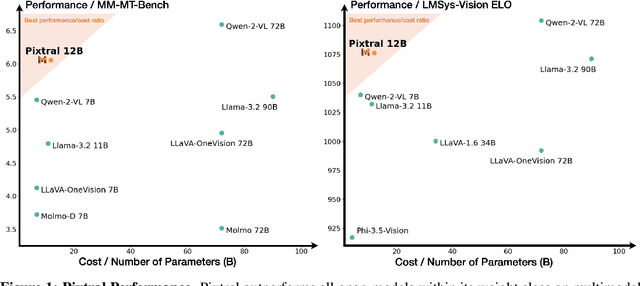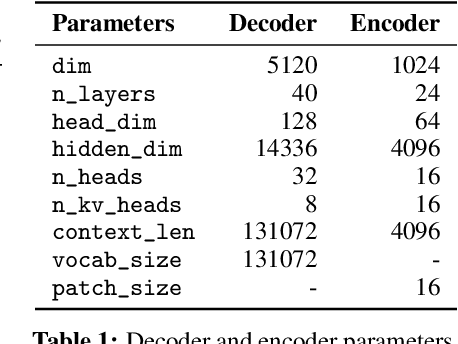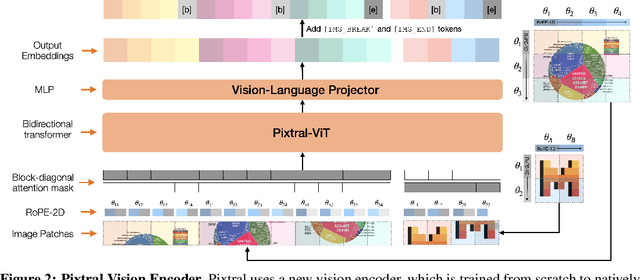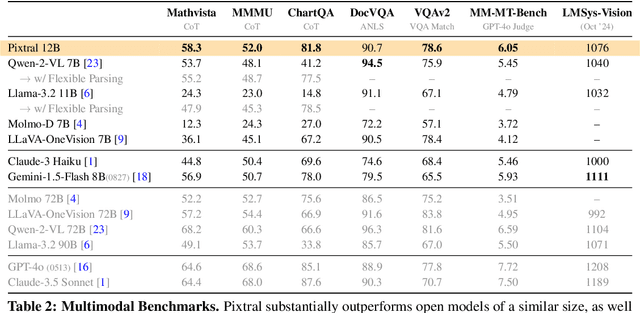Patrick Von Platen
Pixtral 12B
Oct 09, 2024



Abstract:We introduce Pixtral-12B, a 12--billion-parameter multimodal language model. Pixtral-12B is trained to understand both natural images and documents, achieving leading performance on various multimodal benchmarks, surpassing a number of larger models. Unlike many open-source models, Pixtral is also a cutting-edge text model for its size, and does not compromise on natural language performance to excel in multimodal tasks. Pixtral uses a new vision encoder trained from scratch, which allows it to ingest images at their natural resolution and aspect ratio. This gives users flexibility on the number of tokens used to process an image. Pixtral is also able to process any number of images in its long context window of 128K tokens. Pixtral 12B substanially outperforms other open models of similar sizes (Llama-3.2 11B \& Qwen-2-VL 7B). It also outperforms much larger open models like Llama-3.2 90B while being 7x smaller. We further contribute an open-source benchmark, MM-MT-Bench, for evaluating vision-language models in practical scenarios, and provide detailed analysis and code for standardized evaluation protocols for multimodal LLMs. Pixtral-12B is released under Apache 2.0 license.
Progressive Knowledge Distillation Of Stable Diffusion XL Using Layer Level Loss
Jan 05, 2024Abstract:Stable Diffusion XL (SDXL) has become the best open source text-to-image model (T2I) for its versatility and top-notch image quality. Efficiently addressing the computational demands of SDXL models is crucial for wider reach and applicability. In this work, we introduce two scaled-down variants, Segmind Stable Diffusion (SSD-1B) and Segmind-Vega, with 1.3B and 0.74B parameter UNets, respectively, achieved through progressive removal using layer-level losses focusing on reducing the model size while preserving generative quality. We release these models weights at https://hf.co/Segmind. Our methodology involves the elimination of residual networks and transformer blocks from the U-Net structure of SDXL, resulting in significant reductions in parameters, and latency. Our compact models effectively emulate the original SDXL by capitalizing on transferred knowledge, achieving competitive results against larger multi-billion parameter SDXL. Our work underscores the efficacy of knowledge distillation coupled with layer-level losses in reducing model size while preserving the high-quality generative capabilities of SDXL, thus facilitating more accessible deployment in resource-constrained environments.
AfroDigits: A Community-Driven Spoken Digit Dataset for African Languages
Apr 04, 2023Abstract:The advancement of speech technologies has been remarkable, yet its integration with African languages remains limited due to the scarcity of African speech corpora. To address this issue, we present AfroDigits, a minimalist, community-driven dataset of spoken digits for African languages, currently covering 38 African languages. As a demonstration of the practical applications of AfroDigits, we conduct audio digit classification experiments on six African languages [Igbo (ibo), Yoruba (yor), Rundi (run), Oshiwambo (kua), Shona (sna), and Oromo (gax)] using the Wav2Vec2.0-Large and XLS-R models. Our experiments reveal a useful insight on the effect of mixing African speech corpora during finetuning. AfroDigits is the first published audio digit dataset for African languages and we believe it will, among other things, pave the way for Afro-centric speech applications such as the recognition of telephone numbers, and street numbers. We release the dataset and platform publicly at https://huggingface.co/datasets/chrisjay/crowd-speech-africa and https://huggingface.co/spaces/chrisjay/afro-speech respectively.
 Add to Chrome
Add to Chrome Add to Firefox
Add to Firefox Add to Edge
Add to Edge